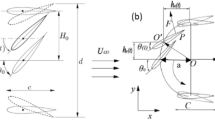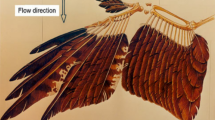Abstract
Helical tip vortices in the wake of a wind turbine have been investigated in this study. To elucidate the near-wake flow field of the wind turbine, the wake has been explored in the Reynolds number (Re) range 1000 ≤ Re ≤ 5000 using qualitative dye flow visualization and quantitative digital particle-image velocimetry techniques. Flow visualization showed the dye getting trapped in the shape of spirals surrounding the helical vortex cores. It was found that the helical vortex core size was increasing with downstream distance. It was also found that the normalized stream-wise component of the wake velocity decreased with increasing tip-speed ratios. The results indicate that vorticity peaks at the center of the core and it decays as the vortex moves downstream, showing that the viscous dissipation is active even at length scales of approximately 5 diameters.










Similar content being viewed by others
References
Adrian RJ (2005) Twenty years of particle image velocimetry. Exp Fluids 39:159–169
Alfredsson PH, Dahlberg JA (1979) A preliminary wind tunnel study of windmill wake dispersion in various flow conditions. Technical Note AU-1499, Part 7, FFA, Stockholm, Sweden
Calaf M, Meneveau C, Meyers J (2010) Large eddy simulation study of fully developed wind-turbine array boundary layers. Phys Fluids 22(1):015110(1–16)
Corten GP, Veldkamp HF (2001) Insects can halve wind-turbine power. Nature 412:41–42
Ebert PR, Wood DH (1997) The near wake of a model horizontal-axis wind turbine: Part 1: experimental arrangements and initial results. Renew Energ 12(3):225–243
Fisichella CJ (2001) An improved prescribed wake analysis for wind turbine rotors. Ph.D. Thesis, University of Illinois, Urbana, Illinois, USA.
Guj G, Terzitta M, Arsuffi G (1991) Velocity measurements upstream of a windmill rotor model. Wind Energy 15(5):248–260
Hand M, Simms D, Fingersh L, Jager D, Cotrell J, Schreck S, Larwood S (2001) Unsteady aerodynamics experiment phase vi: wind tunnel test configurations and available data campaigns. Technical report NREL/TP-500–29955, NREL
Huang HT, Fiedler HE (1993a) Limitation and improvement of PIV, Part 1: limitation of conventional techniques due to deformation of particle image patterns. Exp Fluids 15:168–174
Huang HT, Fiedler HE (1993b) Limitation and improvement of PIV, Part 2: particle image distortion, a novel technique. Exp Fluids 15:263–273
Kocurek JD, Tangler JL (1977) A prescribed wake lifting surface hover performance analysis. J Am Helicopter Soc 22(1):24–35
Kozmar H (2010) Scale effects in wind tunnel modeling of an urban atmospheric boundary layer. Theor Appl Climatol 100:153–162
Landgrebe AJ (1972) The wake geometry of a hovering helicopter rotor and its influence on rotor performance. J Am Helicopter Soc 17(4):4–15
Light JS, Swanson AA, Norman TR (1992) Application of the wide-field shadowgraph technique to helicopters in forward flight. J Am Helicopter Soc 37(2):23–28
Okulov VL (2004) On the stability of multiple helical vortices. J Fluid Mech 521:319–342
Okulov VL, Sorensen JN (2007) Stability of helical tip vortices in a rotor far wake. J Fluid Mech 576:1–25
Okulov VL, Sorensen JN (2010) Maximum efficiency of wind turbine rotors using Joukowsky and Betz approaches. J Fluid Mech 649:497–508
Raffel M, Willert C, Wereley S, Kompenhans J (2007) Particle image velocimetry, a practical guide, 2nd edn. Springer, Berlin Heidelberg New York
Rinehart SA (1971) Effects of modifying a rotor tip vortex by injection on downwash velocities, noise, and airloads. J Am Helicopter Soc 16(4):48–54
Schreck S (2002) The NREL full-scale wind tunnel experiment introduction to the special issue. Wind Energy 5:77–84
Shimizu Y, Kamada Y (2001) Studies on a horizontal axis wind turbine with passive pitch-flap mechanism (performance and flow analysis around wind turbine). J Fluids Eng 123:516–522
Sorensen JN (2011) Aerodynamic aspects of wind energy conversion. Annu Rev Fluid Mech 43:427–448
Tsustui Y, Matsumya H (1987) LDV measurements of flow field around a wind turbine. Wind Power 7:381–386
Varshney K, Poddar K (2011) Experiments on integral length scale control in atmospheric boundary layer wind tunnel. Theor Appl Climatol 106(1–2):127–137
Varshney K, Poddar K (2012) Prediction of wind properties in urban environments using artificial neural network. Theor Appl Climatol 107(3–4):579–590
Vermeer LJ (2001) A review of wind turbine wake research at TU Delft. A Collection of the 2001 ASME Wind Energy Symposium Technical Papers. ASME, New York
Vermeer LJ, Timmer WA (1999) Identification of operational aerofoil state by means of velocity measurements. In: European Wind Energy Conference, Nice, France, pp 168–171
Whale J (1996) Investigating fundamental properties of wind turbine wake structure using particle image velocimetry. In: 10th International IEA symposium on wind turbine aerodynamics. IEA, Vienna
Whale J, Anderson CG, Bareiss R, Wagner S (2000) An experimental and numerical study of the vortex structure in the wake of a wind turbine. J Wind Eng Ind Aerod 84:1–21
Widnall SE (1972) The stability of a helical vortex filament. J Fluid Mech 54:641–663
Yang Z, Sarkar P, Hu H (2011) An experimental investigation on the wake characteristics of a wind turbine in an atmospheric boundary layer wind. In: 29th AIAA Applied Aerodynamics Conference, pp 1–18
Acknowledgements
The author expresses his sincere thanks to the technical staff of the Department of Mechanical and Industrial Engineering, University of Massachusetts, Amherst for manufacturing wind turbine blades and their assistance in building experimental set-up employed in this study.
Author information
Authors and Affiliations
Corresponding author
Rights and permissions
About this article
Cite this article
Varshney, K. Characteristics of helical tip vortices in a wind turbine near wake. Theor Appl Climatol 111, 427–435 (2013). https://doi.org/10.1007/s00704-012-0672-4
Received:
Accepted:
Published:
Issue Date:
DOI: https://doi.org/10.1007/s00704-012-0672-4




